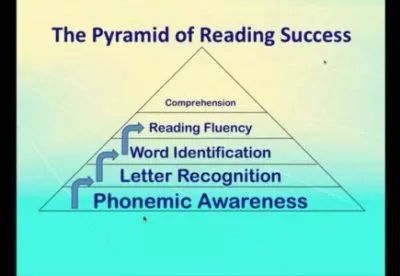You Can Teach Early Literacy Skills to your Child--Part 1
For many parents, myself included, the idea of teaching your child to read is daunting to say the least. Something that important should be left up to the experts, right? Well maybe not, especially with statistics like these (according to U.S. Department of Education):

- 32,000,000 adults in the U.S. can’t read
- 19% of high school graduates can’t read
- Only 13% of adults in the U.S. are “proficient” readers
- 70% of prison inmates in the U.S. can’t read
Hmmm, that’s scary. But what is a parent to do? How can I, a parent who’s not a teacher, succeed where the system is failing? Actually, according to Master Montessori teacher and Early Reading Specialist, Randall Klein, teaching your child to read is totally do-able. As long as you follow the clearly defined steps, in sequence, learning to read is “child’s play!”
In the free online webinar entitled “Essential Skills for Beginning and Struggling Readers,” Randall Klein gives us a basic outline of the steps involved (more in-depth information is also available, which we’ll get to a little later in this blog.) Randell starts with this “Pyramid of Reading Success.”

The pyramid shows us--in order--the steps the child will take toward learning to read. For example, as you can see from the graphic above, the progress toward literacy begins with phonemic awareness. Only when the child has demonstrated a solid understanding of phonemic awareness would he be ready to go on to the next level of the pyramid.
It is important to understand that the child’s progress is NEVER forced, and the child is never-EVER pushed to advance more quickly. Instead, we follow the child’s lead. This allows her (or him) to set the pace and be motivated by her own inner desire to learn. As Maria Montessori understood, children under the age of six or seven years old are predisposed toward learning to read and write. They will want to learn, just at their own pace.
We should realize that if a child has learned to speak, he has a language and a way to express his personality. He has created from nothing, a way to let others to know him as a person. Reading and writing are no more difficult to acquire than speaking is, since they are also ways to communicate. It is the adult who makes learning to read and write difficult when he or she approaches the two as subjects to be conquered, rather than discoveries to be made.
~ Maria Montessori
So what is this all-important foundation to reading success called “phonemic awareness”? Phonemic awareness is the very simple but critical ability (of the child) to be able to hear and recognize the individual sounds of spoken words. Children with phonemic awareness understand that words are made of a sequence of smaller sounds.
According to Randall, there are five essential skills for the foundations of literacy:
- Beginning sound isolation
- Using the alphabetic principle to identify sounds of letters
- Phoneme segmentation
- Encoding words with moveable letters
- Decoding words using letter-sounds
Beginning sound isolation is the child’s ability to recognize the first sound, or phoneme, at the beginning of a word. Children learn through simple repetition to recognize that each word begins with its own distinct sound. This idea is a big step toward phonemic awareness. Keep in mind that you are not introducing letters at this point, just the beginning sounds.
Parents can familiarize children with this concept simply by articulating the beginning sounds of words, followed by the whole word, frequently throughout the day. For example, you could make it a game you “play” whenever you’re in the car. “Look Mary, it’s a /d/-dog. Oh, and over there I see a /b/-bike.” Repeat, repeat, repeat…eventually, they child will start to do this herself.
Note: When you articulate beginning sounds, stick to just the one sound. It is common for people to tack a vowel sound to certain consonants; for example you might say “zuh-zebra” instead of “zzzz-zebra,” or “nuh-nut” instead of “nnn-nut.” This is a bad habit as it can make things confusing later when the child is learning to blend sounds together.
When it comes to using the alphabetic principle to identify sounds of letters, Randell tells us the key is to “teach the alphabetic principle before you teach the alphabet.” Once a child can isolate the beginning sound of a word in a picture, he or she can understand the alphabetic principle. The alphabetic principle is the association of a sound with the symbol we call a letter.
Phoneme segmentation is the child’s ability to break words down into sound parts (phonemes.) And is, according to Randall, “the most important reading readiness skill of everything in the known universe!” For (much!) more information on phoneme segmentation, please view our webinars Learning to Read is Child’s Play Part I and Learning to Read is Child’s Play Part II.
To find out more about encoding words with movable letters and decoding words using letter-sounds, check back next week for part 2 of “You Can Teach Early Literacy Skills to your Child at Home.”
Note: This blog is intended to be just a brief introduction, and to inform parents that you can teach your children to read! For a comprehensive, step-by-step program that includes everything you need to teach your child to read, discover The Royal Road to Reading Program: an early childhood reading program for teachers, parents, grandparents, and homeschoolers.




















